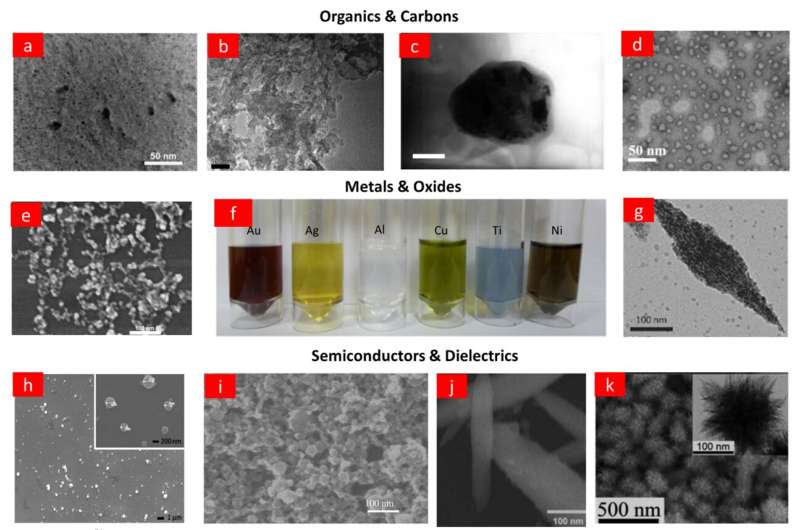Functional nonlinear optical nanoparticles synthesized by laser ablation

Nonlinear optics is an important research direction with various applications in laser manufacturing, nanostructures' fabrication, sensor design, optoelectronics, biophotonics, and quantum optics, etc. Nonlinear optical materials are the fundamental building blocks, which are critical for broad fields ranging from scientific research, industrial production, to military. After many years of development, nonlinear optics has become the pillars for various frontier research and widely used optical systems, including laser fabrication, optical imaging, information processing & communications, as well as nanoscale lithography. Advances in this topic can potentially boost many disciplines.
Nanotechnologies have paved the ways to engineer new materials and break the conventional limits for nonlinear optics. Nanoparticles are one of the most important members that are widely studied, which has a long history of thousands years. Nanoparticles demonstrate great potentials due to their flexibility to engineer and enhance their nonlinear optical properties superior to their bulk counterparts. In the past decade, optical devices and components based on nonlinear optical nanoparticles are receiving more and more attentions due to their enhanced performance and multifunctional capabilities. Many of them also show good biocompatibility, which extends the application scope for nonlinear optical devices.
Thus, nanoparticles are widely used for nonlinear optical applications. For the nanoparticles' synthesis, how to produce nonlinear optical nanoparticles with large scale, high repeatability, and low cost remains to be a challenge. To address this challenge, various synthesis approaches have been investigated. Chemical and laser ablation approaches are two primary synthesis methods. Chemical approaches are useful to produce nanoparticles at an industrial scale. For chemical approaches, there also exist limitations including impurities and agglomeration. On the other hand, laser ablation is a more direct, environmentally friendly, and universal method for nonlinear optical nanoparticles' synthesis. Great flexibility and possibilities are offered for applications based on nonlinear optical nanoparticles to fulfill the requirements of different devices.
The research group of Prof. Hong Minghui from National University of Singapore reviews the latest progresses on the nonlinear optics related to the light amplitude/intensity. The saturable absorption and optical limiting are two nonlinear phenomena to describe the transmission change of a material system. The saturable absorption is the process when the light absorption decreases with light intensity. In other words, a material with the saturable absorption tends to be more "transparent" under stronger incident light irradiation. Materials with the saturable absorption are widely used to fabricate high power lasers.
On the other hand, the optical limiting describes the opposite effect. An optical limiting material reduces the transmission of light when the light intensity increases. Hence, the optical limiting is also denoted as the reverse saturable absorption. It is also a critical effect with applications ranging from protective materials, military weapons, optical switching, to high power laser sources.
In spite of their importance, both the saturable absorption and optical limiting normally require incident light with high intensity. Hence, they are mostly observed in devices using a pulsed laser with high peak power. This condition can possibly result in permanent optical damage. It is also a critical bottleneck to limit practical applications for the complicated design and high-power lasers cost. The investigation of suitable materials with superior nonlinear properties is a primary research direction in this field. The progress shall not only greatly promote the performance of current optical nonlinear systems, but also bring about new opportunities to design functional devices to address the increasing needs for quantum optics, advanced sensors, artificial intelligence, next-generation optical computers, and many other frontier topics.
This review, published in Opto-Electronic Science, summarizes the recent progresses in this direction, which focuses more on the methodologies with a series of case studies as the illumination. It also covers extended topics to provide additional views on their key advantages and achievements. The challenges and future research trends are another focus, with the latest research works to introduce new opportunities and potentials. The development of the nonlinear optical nanoparticles synthesized by laser ablation are summarized, which demonstrates its capability for enhanced performance and multiple functions. Nanoparticles' synthesis by laser ablation proves to be a green, efficient, and universal physical approach, versatile for fast one-step synthesis and potential mass production.
More information: Lianwei Chen et al, Functional nonlinear optical nanoparticles synthesized by laser ablation, Opto-Electronic Science (2022). DOI: 10.29026/oes.2022.210007
Provided by Compuscript Ltd




















